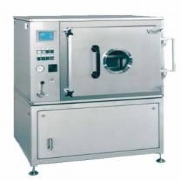Vacuum Dryers
Vacuum heating and drying ovens for the gentle drying of temperature sensitive, easy decomposable goods and components with a complex geometry (decreased temperature of ebullition and higher drying rate under vacuum conditions), also available in explosion-proof designVVT Series
You can dry products from almost all branches of industry in a vacuum drying oven, e. g.:
Pharmaceutical industry
Chemical industry
Cosmetics industry
Food processing industry
Electrical and electronic engineering
Precision engineering and optics
Aerospace industry
Research and development
Microstructure techniques
Nanotechniques
Plastics and ceramics
Textiles
Surface techniques
The Advantages
The advantages of using the Votsch VVT Vacuum Oven…..
Heat-sensitive mediums (e. g. pharmaceutical products) are dried with care
Reduced drying times due to lowering of the pressure
Due to the extremely low remaining oxygen content in the drying oven there are no oxidation processes
Evaporating fluids (e. g. solvents) can be recovered
Optimum drying conditions for light, powdery products as there is no turbulence (no convection)
No “skin-forming” on the product being dried; therefore constant drying performance
Economic because steam or warm water from other processes can be used as a heat medium
Flexible heating.
Range of Applications
Design
Our vacuum drying ovens are of compact design. The major components are:
- Drying oven with shelves
- Heating and cooling aggregate for the thermal medium
- Vacuum pump
- Condenser with storage vessel.
Construction Features
All components of the drying oven itself are of stainless steel with material class 1.4571 as these may come into contact with the product. The external housing and reinforcements are made of stainless steel with the material class 1.4301.
The interior of the drying oven is designed in compliance with GMP-/FDA regulations. This is important when the product being dried should on no account react to other substances or when product entrainment shall be prevented during loading/unloading.
Heating Modes
We offer four heating solutions:
- Electrical
- With heating medium
- Infrared radiation
- Microwave (HF).
The first two processes are based on the principle of contact heating. This means that the heat is conducted from the heat medium through contact areas to the product. With the electrical version, tubular heaters are fed in coils through the hollow shelves (sandwich construction). With the version using heat medium you have three possibilities:
- Warm water
- Thermal oil
- Steam.
If you wish to heat using a heat medium, we equip the drying oven with pressure-tight, hollow shelves.
The difference from the electrical version is that the heat transfer medium flows through channels and then fills the entire cavity of the shelf. A separate thermostat controls the temperature of the heat medium. The heated medium is pumped in a cycle through the individual shelves. With the steam heating version a special valve is responsible for controlling the amount of steam. This control operates without auxiliary power so that it is possible to use this type of control in an explosion-proof room. With steam it is possible to heat in two different ways, the temperature of the steam being important:
- When T is <100 °C the steam is routed into a heat exchanger where the heat energy of the steam is transferred to the water. The heated water is pumped through the shelves.
- When T is >100 °C the steam is fed into the distribution system for the shelves.
Visit the Weiss Gallenkamp website for more information on Vacuum Dryers


